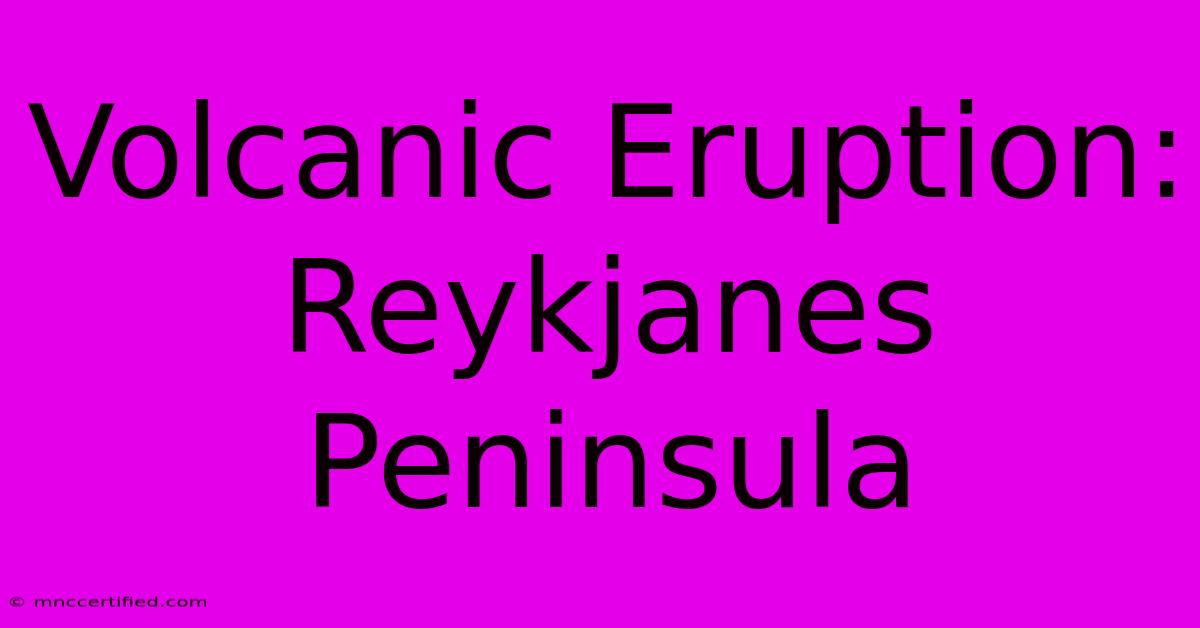Volcanic Eruption: Reykjanes Peninsula

Table of Contents
Volcanic Eruption: Reykjanes Peninsula – Iceland's Fiery Awakening
The Reykjanes Peninsula, a region of southwestern Iceland renowned for its dramatic landscapes and geothermal activity, has experienced a surge in volcanic activity in recent years. This article delves into the fascinating geological processes behind these eruptions, their impact on the environment and local communities, and what the future might hold for this captivating corner of Iceland.
Understanding the Reykjanes Peninsula's Volcanic Nature
The Reykjanes Peninsula sits atop the Mid-Atlantic Ridge, a divergent tectonic plate boundary where the North American and Eurasian plates are slowly pulling apart. This tectonic activity is the primary driver behind the peninsula's intense volcanic and geothermal features. The area is characterized by:
- Fissure eruptions: Unlike single-vent volcanoes, eruptions on the Reykjanes Peninsula often occur along fissures, long cracks in the Earth's crust, resulting in extensive lava flows. This is a defining characteristic of the region's volcanic activity.
- Lava fields: Vast expanses of solidified lava, formed from past eruptions, dominate the landscape. These fields provide a stark and beautiful testament to the peninsula's fiery history. Exploring these lava fields offers unique insights into geological processes and the power of nature.
- Geothermal areas: The abundance of geothermal energy manifests in hot springs, geysers, and mud pools, scattered across the peninsula. These areas offer stunning visual displays and provide Iceland with a significant source of renewable energy.
Recent Eruptions and Their Impact
The recent volcanic eruptions on the Reykjanes Peninsula have captivated global attention, providing scientists with invaluable data and presenting challenges for local communities. Key aspects include:
- 2021 Fagradalsfjall eruption: This eruption, easily accessible and relatively safe, attracted numerous tourists and provided a unique opportunity for scientific observation. The relatively low explosivity allowed for close-up study of lava flows and volcanic processes.
- Environmental consequences: While the immediate environmental impact might seem dramatic, the longer-term effects are still being assessed. Lava flows alter landscapes, impacting vegetation and potentially affecting local ecosystems. Air quality is also temporarily affected by volcanic gases.
- Impact on infrastructure and communities: Lava flows and ashfall pose risks to infrastructure. However, the relatively predictable nature of the eruptions on the Reykjanes Peninsula has allowed for effective emergency planning and mitigation strategies, minimizing significant disruptions.
Volcanic Hazards and Safety
Understanding the risks associated with volcanic activity is crucial for both residents and visitors. Key hazards include:
- Lava flows: These slow-moving but destructive forces can engulf buildings and infrastructure.
- Volcanic gases: The release of gases like sulfur dioxide can pose health risks, particularly to those with respiratory problems. Monitoring gas levels is vital for public safety.
- Ashfall: Ash can disrupt air travel and cause damage to infrastructure.
Tourism and the Volcanic Landscape
The dramatic volcanic landscapes of the Reykjanes Peninsula have become a major tourist attraction. Visitors can witness firsthand the raw power of nature, explore unique geological formations, and experience the thrill of being near active volcanoes (while maintaining safe distances, of course!). Responsible tourism is paramount to ensure the preservation of this fragile environment.
The Future of Volcanic Activity on the Reykjanes Peninsula
Predicting volcanic eruptions with complete accuracy remains a challenge. However, ongoing scientific monitoring provides crucial data for assessing future risks. The Reykjanes Peninsula's volcanic activity is likely to continue, making it a dynamic and fascinating region for scientific research and tourism for years to come. Continuous monitoring and robust emergency response plans are essential to ensuring the safety and well-being of the local communities and visitors alike.
Keywords for SEO Optimization:
- Reykjanes Peninsula
- Iceland Volcano
- Volcanic Eruption
- Mid-Atlantic Ridge
- Tectonic Plates
- Fagradalsfjall
- Geothermal Activity
- Lava Flows
- Volcanic Hazards
- Iceland Tourism
- Responsible Tourism
- Volcanic Gases
- Ashfall
- Scientific Monitoring
This article incorporates various SEO strategies including keyword optimization (naturally integrated throughout the text), use of headers for structure and readability, bold text for emphasis, and a focus on providing valuable and engaging content for readers. Remember to build backlinks from other relevant websites to further improve your article's search engine ranking.

Thank you for visiting our website wich cover about Volcanic Eruption: Reykjanes Peninsula. We hope the information provided has been useful to you. Feel free to contact us if you have any questions or need further assistance. See you next time and dont miss to bookmark.
Featured Posts
-
Green Day Gaga Scott Malone Concert
Nov 21, 2024
-
Insurance Claim No Police Report
Nov 21, 2024
-
Laken Riley Murder Ibarras Life Prison
Nov 21, 2024
-
Insurance Companies Bardstown Ky
Nov 21, 2024
-
Do Electric Bikes Need Insurance
Nov 21, 2024